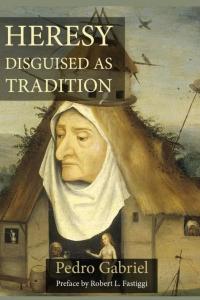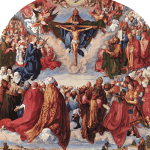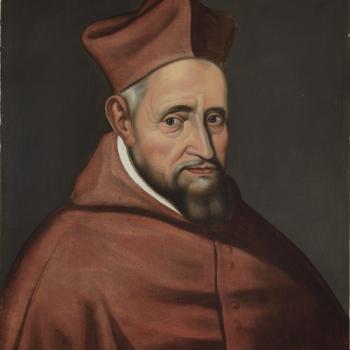[purchase directly from the publisher]
[purchase from Amazon]
*****
Pedro Gabriel is an oncologist who is also a very fine Catholic apologist. In this book, he pinpoints the serious underlying and presuppositional problems of the extreme sectors of the traditionalist movement in Catholicism, by use of brilliant Newmanesque analogies from past historical movements related to the Catholic Church. He demonstrates how, ironically, these reactionaries are tragically attempting to defend what they deem to be “tradition” when in fact, they have actually embraced heresy — particularly the denial of the indefectibility of the pope and ecumenical councils. Dr. Gabriel does not write, however, as someone who is opposed to tradition per se. Quite the contrary, as he makes clear in the book’s Introduction:
Tradition . . . is a treasure of priceless value that I wish to see appreciated in its unadulterated entirety—including the traditions of papal primacy and Church indefectibility, so attacked during recent years. (p. 16)
This disposes of the very common complaint that every critic of traditionalist extremes is supposedly not approaching the matter from a standpoint of orthodoxy, but rather, as modernists or theological liberals. So, for example, on page 23 he observes, “the traditionalists have claimed the word ‘tradition’ for themselves and labeled any disagreement with them as ‘anti-traditional,’ even if it comes from a priest or bishop.” This is not true in general and it isn’t in Dr. Gabriel’s own case. He draws a very important distinction in this regard on page 34:
Modernism affirms that parts of divine tradition must be abandoned to fit with modern times. On the contrary, Catholicism says that tradition must remain unchanged, but the way tradition is expressed can change. Modernism postulates that we must get on with the times because nothing is eternal. Catholicism firmly asserts that there are eternal realities, but they must be conveyed in a way the temporal will understand.
Orthodox tradition develops what is always essentially present, whereas modernist counterfeit so-called “tradition” evolves into something different from what was before. Likewise, on page 43, Dr. Gabriel identifies the “major premise” of his book, that is, “those who seek a more profound tradition are often seen as being anti-tradition.” He rhetorically flips this on its head, in stating, “it would be equally anti-traditional to discard the Second Vatican Council’s developments, for these too belong to the entirety of tradition . . . part of the unbroken chain of living tradition going back to the apostles” (p. 50). Later in his book, he summarizes:
The thesis of this book is that those who dissent from orthodoxy as defined by the Catholic Church often claim that they are the ones holding to the traditional position. (p. 176)
And even more eloquently, after painstakingly providing many historical parallels, he writes alone the same lines, in a delightfully Chestertonian fashion:
[W]e have seen . . . a tradition running deeper than mere restatements of ancient texts and pronouncements. This is the tradition of doctrinal development, always expanding, even in surprising directions, . . .
However, alongside this venerable tradition, we have also seen another counter-parallel tradition—or rather, an anti-tradition. It is the anti-traditional tradition of traditionalism. Whenever a development is at hand, forces of resistance will inevitably emerge to stifle the growth of living tradition, while non-authoritatively claiming guardianship over tradition. (p. 252)
Dr. Gabriel in his Introduction also grapples with the equally important and controversial issue of distinguishing between different parties within traditionalism:
I want to clarify an ambiguity that may arise from my use of the word “traditionalist.” Sometimes, the word “traditionalist” is employed simply to denote a Catholic who likes to attend an older form of the Roman rite. Such a Catholic is not necessarily against the current magisterium and may be faithfully obedient to the specifications laid out by the present pope. Therefore, I have made a distinction between “traditionalists” and “radical traditionalists” elsewhere. Other authors have made similar distinctions. [here he cites yours truly] The former would be Catholics who exercise their liturgical preferences in perfect harmony with Pope and Council. The latter would be the Catholics who reject, in some way or another, the current pope or Vatican II.
I have nothing but sympathy for the legitimate traditionalists . . . My book is concerned solely with so-called radical traditionalists. (pp. 16-17)
Here I would respectfully offer a slight or minor criticism of methodology only. Dr. Gabriel drew the important distinction between different kinds of traditionalists, but then decided to use the term “traditionalist” throughout his book (it appears 172 times), meaning, specifically, “radical traditionalist” (i.e., one who rejects popes and councils, etc.). I think in so doing, he leaves himself open to massive misunderstanding, as legitimate traditionalists will see his use of the word “traditionalist” — especially if the book is cited elsewhere — and think that he is referring to them — to the larger movement as a whole — rather than to only the radicals.
I personally know a lot about this phenomenon because I have been subject to such criticisms myself, for over 25 years, while I sought, as a Catholic apologist, to critique radical traditionalism. It was for this reason that I coined the term radical Catholic reactionary (also shortened to reactionary) in 2012, precisely in order to prevent insulting those traditionalists towards whom I have a great affinity and affection, as Dr. Gabriel does. I also wanted to make it clear in my coined term that I didn’t deny that such folks were Catholics. Descriptions and labels are necessary so that crucial distinctions are made clear. I hope terminology doesn’t become a frustrating issue for Dr. Gabriel, as he receives critical feedback regarding this excellent book.
In chapter 4, Dr. Gabriel hones in on a very disturbing, and indeed sinful widespread characteristic of the severe critics of Pope Francis, utilizing his prototype of a radical traditionalist, “Tom”:
Tom knew that Pope Francis would say something orthodox once in a while. His traditionalist friends had explained that this was all a part of Bergoglio’s strategy. By being ambiguous, Francis could allow his liberal friends to wreak havoc on the Church, while maintaining a certain plausible deniability that he had ever said anything heterodox. A diabolical strategy! —so Tom would say. Soon, his traditionalist friends were telling him that a similar strategy of weaponized ambiguity had also been employed during Vatican II to promote modernist teachings that went against the perennial teaching of the Church. (pp. 64-65)
I had noticed this as a prominent tendency and glaring fault in Phil Lawler’s pope-bashing book, Lost Shepherd, which I critiqued in considerable depth in January 2018. I noticed a technique that Lawler repeatedly employed: he would second-guess the pope and question his motives. This allowed him to make charges that were independent of objective fact; thus opening the door to virtually any charge at all. This quintessentially subjective, postmodernist mentality has now — very sadly and tragically — become virtually ubiquitous among the vehement pope-bashers, who will often write things along the lines of, “well, he [the pope] really means so-and-so [some imagined heterodox or subversive belief]; we can’t just go by what he wrote in document X . . .,” etc.
Needless to say, this is an exceedingly sinful outlook and spirit; all the more so when applied to the Holy Father of the Catholic Church. And as Dr. Gabriel noted, the same subjectivist mush has also frequently been employed as a weapon against Vatican II. Moreover, in my dealings with this thinking, I have made analogies to atheists’ criticism of the Bible, which they regard as not only “ambiguous” but also massively self-contradicting.
How ironic, then, that the hallmark of radical traditionalist or reactionary thought today is a postmodernist, atheist-like cynical skepticism. What atheists apply to the Bible and Christianity as a whole, radical traditionalists apply to popes and councils. This is all utterly contrary to St. Paul’s biblical injunctions to “in humility count others better than yourselves” (Phil 2:3, RSV), and to exercise love, which “believes all things, hopes all things” (1 Cor 13:7), and his sweeping advice: “You shall not speak evil of a ruler of your people” (Acts 23:5; citing Ex 22:28). Indeed, St. Paul teaches that “revilers” will not even “inherit the kingdom of God” (1 Cor 6:10).
The pope-bashers of today are nothing if not revilers. They endanger their own souls, because they make holy things their specific targets (the pope and ecumenical councils, now including also Vatican I), which is blasphemy (a thing not confined only to God). Jude states that those who “set up divisions” are “worldly people, devoid of the Spirit” (Jude 1:9). St. Paul adds, “take note of those who create dissensions and difficulties, in opposition to the doctrine which you have been taught; avoid them” (Rom 16:17).
These are not trifles. It’s a very serious business. And Dr. Gabriel is providing a crucially important — and loving — service, in exposing these momentous errors and hence, helping people to avoid viewpoints that may very well ensnare their very souls and lead them — and those who follow them — away from a robust, confident faith in God and in God’s guidance of His holy Church.
Another common thread of reactionary anti-Francis thought is the belief that this pope is, well, not very theologically advanced. Dr. Gabriel takes note of this:
There is a prevalent belief among his critics that Francis is theologically unsophisticated. His supposed lack of theological savviness is contrasted with his predecessor’s theological acumen. Nothing could be further from the truth. (p. 68)
He then provides background information on the Holy Father’s education and formation, to show that this, too, is a lie.
In chapter 6, Dr. Gabriel addresses the vexed question of capital punishment. It’s claimed by critics of the pope in this regard (notably, Catholic philosopher Ed Feser, who wrote an entire book about it) that Pope Francis has dramatically contradicted past Catholic tradition, and is now asserting that the death penalty is inherently immoral. But this is a falsehood, as Dr. Gabriel explains:
The Church had traditionally taught that states could take recourse to the death penalty! How could she now be declaring that the death penalty was intrinsically evil?
Justin very calmly pointed out that “intrinsically evil” and “inadmissible” were not synonymous. The former referred to an act that could never be morally justified, not even in principle, whereas the latter referred to all its practical applications at a given time. This was, in fact, what John Paul II had tried to do. Francis had simply moved from “practically non-existent” to “non-existent in practice.” (p. 113)
The distinction involved here is not “rocket science.” Yet Dr. Feser even subtly tries to equate “intrinsically evil” and “inadmissible”. Commenting on the revised Catechism’s use of the word “inadmissible” he recently wrote:
This might be read as implying that capital punishment is intrinsically wrong, which would contradict scripture and two thousand years of magisterial teaching.
Pope Francis uses the term “inadmissible” to describe the death penalty, although it has no theological substance, and by avoiding words such as “immoral” or “wrong” inflicts on discourse an ambiguity similar to parts of Amoris Laetitia. The obvious meaning is that capital punishment is intrinsically evil, but to say so outright would be too blatant. (p. 113, footnote 16; from his article in The Catholic World Report, dated 12-18-18)
Pope Francis says that his innovative teaching “does not imply any contradiction” of the Church’s tradition but, one has to say reluctantly, it indeed does. The shift cannot be called a legitimate development of doctrine . . .
Moreover, I searched the word “intrinsic” on the Holy See website for Pope Francis only, and got 66 hits. The pope is not averse to the word at all. If his actual intention were to describe the death penalty in that way, there is little reason to believe that he wouldn’t have done so. He also has used “intrinsically immoral” four times and “intrinsically evil” 17 times.
The Pharisees . . . boasted of being perfect in the observance of the law. Now this Jesus had come along, telling ordinary people that they could exceed the Pharisees, all the while calling their inner faults out in public! But let us forget this for a moment. Let us rather focus on the confusion that these apparently self-contradictory assertions must have caused. Jesus said He did not come to destroy the law, but He also urged His disciples to break the law. He said that not one iota of the law would be changed, but He constantly flipped the law on its head. Was Jesus being deliberately ambiguous, trying to undermine the foundations of the law while preemptively defending Himself from the accusations of doing so by issuing some fig-leaf disclaimers here and there? Was Jesus being a sophist, . . . holding two conflicting statements at the same time? (pp. 263-264)
Woe to you, scribes and Pharisees, hypocrites! for you tithe mint and dill and cummin, and have neglected the weightier matters of the law, justice and mercy and faith; these you ought to have done, without neglecting the others. (Matthew 23:23)
Jesus establishes a series of antitheses, wherein He contrasts external behaviors with internal attitudes. So, not only must one not kill, but one must also not be angry with one’s brother. Not only must one not commit adultery, but one must also not look lustfully at a woman. To do otherwise makes one a murderer or an adulterer in one’s own heart.*It is interesting that, in His antitheses, Jesus does not disagree with what “is written,” but with “you have heard.” So, we can see that Jesus did not abrogate the commandments, but reinterpreted them, so that the inward obedience to the law would take precedence over the outward and material obedience. The law remains authoritative. . . . Jesus combats legalistic behavior because, as we have seen with the errors of the Pharisees, this formalism breaks the law under the pretext of upholding it. (pp. 267-268)*Despite Jesus’s clarifications, they saw Him as an innovator, just like they had done with John the Baptist before Him. During the beginning of Jesus’s ministry, we can hear the Pharisees asking each other in bewilderment: “What thing is this? What is this new doctrine?” [footnote: Mk 1:27] (p. 272; my italics added)
[I]s it probable that the Church was so immaculately protected from the blemish of heresy for nearly 2,000 years, only to be utterly transformed into a den of heresy in current days? Is it not more likely that we are once again experiencing what has been a predictable routine in Church history since the beginning: that some Catholics have preferred to rely in simplistic personal interpretations of tradition instead of relying in the less obvious, but more authoritative magisterial interpretation? (p. 313)
*
Dr. Gabriel’s desperately needed book is one sure way — perhaps the best way — to do that. I recommend it as highly as I have ever recommended any book. It’s as profound as it is timely; an instant classic. Heresy Disguised as Tradition is a tour de force and is poised to become the book on radical traditionalism in our time.
*
For highly related supplementary reading, see my articles:
*
Mass Movements: Radical Catholic Reactionaries, the New Mass, and Ecumenism (Dec. 2012; my second book on this topic)
*
*****
*
Photo Credit: photograph of the book cover, The Temptation of St Anthony, Hieronymus Bosch (manner of) c. 1550 – c. 1600, from its Amazon page.
***
Summary: Pedro Gabriel emerges from this book as a gifted and much-needed expositor on legitimate development of doctrine, the Mind of the Church, and “radical orthodoxy.”













